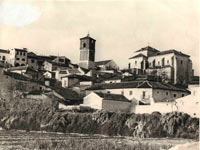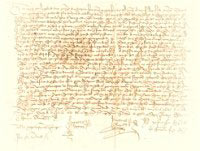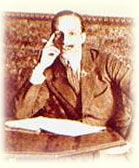Tourism web of Chinchón (Spain)
History
History of Chinchón
Chinchón is one of the most picturesque and best known towns within the Autonomous Community of Madrid and the fact that it lies very close to the capital city has not impinged on its conserving its own personality, with its dark gray and ochre colored landscapes, bunches of houses grouped upon hills surrounding its unique main Square and its winding streets that are a witness to the life and the history of the village.
The town of Chinchon was declared, in 1974, a Historical Site by the Council of Ministers. Thanks to this fact starts the height of the hospitality industry and tourism, making Chinchón one of the most popular destinations, both domestically and internationally.
From Prehistory to the Muslim invasion

The first prehistoric relics date back to the Neolithic. From this period are the many caves in the area. The best known is the Cueva de la Mora. In the so-called Cerro del Salitral were discovered remains of an Iberian city with a necropolis.
In Roman times, Chinchón became a farming town, accepting their civilization, laws and customs (no data of ancient discovery of a Roman tombstone in the eighteenth century, served as a door lintel of a house in the Plaza Mayor).
Then came the Arab rule, which was subject to three and a half centuries, Chinchón belonged to the kingdom of Toledo. With the conquest in 1060 by Fernando I El Magno and the subsequent reconquest by Alfonso VI in 1083, the people would be out of Muslim rule and linked to the City of Segovia.
Chinchón, Lordship to County
From the 15th century onwards, under the rule of Juan II, the first document that attests to Chinchón’s history appears, still preserved for posterity, in the city Historical Archive.
Although it was upgraded to Villa by his successor, Henry IV, the most important change during this century would occur in 1480 with the assignment to the Marquis de Moya, Sir Fernando Cabrera and Ms. Beatriz de Bobadilla, the Lordship of Chinchon, awarded by the Catholic Monarchs in appreciation of the services rendered and collaboration against Ms. Juana la Beltraneja, who fought for the throne of Castile.
During this period the Catholic Monarchs made at least five visits to Chinchon, between the years 1494 and 1499, to greet his loyal servants.

Later on September 15, 1502, Juana and Felipe el Hermoso visit and sleep on the town, staying at the Palace of the Marquis, where now stands the theater "Lope de Vega", which unfortunately disappeared because of the War succession.

Fernando Cabrera y Bobadilla, second son and successor of the Marquis, was honored by Carlos V in 1520 with the title of Count. From this fact, Chinchón becomes a county.
His grandson, the third Earl of Chinchon, Sir Diego Fernandez de Cabrera y Bobadilla served King Felipe II. During this time was responsible for the rebuilding of the Castle of the Counts destroyed during the War of the Communities. The count made a financial contribution in 1586 to complete the chapel of the church "Nuestra Señora de la Asunción", moving far the best teachers who had worked in El Escorial. In return, he reserves for himself and his successors a crypt located under the main altar. At this time, preparations begin founding El Convento de las Clarisas, although it was not founded until 1653 by the 5th Count of Chinchon.
In the history of the first Counts must make special mention of a woman, Francisca Enríquez de Rivera, second wife of IV Count of Chinchon, Felipe IV appointed viceroy of Peru. In 1629 took possession of the viceroyalty. A few months after arriving in Lima, Countess starts feeling sick with high fevers that raises fears for his life. The corregidor of Loja, who had suffered the same ailment and was cured by the extract from the bark of a tree that gave him an Indian, was quick to inform the Countess. This extract is quinine, which said the Countess on the fifth day of his administration. Upon regaining Countess orders hoarding large amounts of bark and she herself shared many sick. These people called the quinine "Countess powders". La Condesa through cortex sends Jesuits throughout Europe. Spanish galleons brought large quantities of quinine. The generic name of the machine is "Cinchona".
From the War of Succession to the War of Independence
In the early eighteenth century, Chinchón becomes one of the most important scene of the moment. During the War of Succession, the town was loyal to Felipe V. King received numerous weapons to be used in that conflict and refusing to provide wheat to the troops of the Archduke Carlos. On February 25, 1706 he passes the night in a house that is now known as La Casa de la Cadena. The chain ("Cadena") is putting up a sign and tradition that King preserved when an overnight stay in a house. On 3 August the same year, King Felipe V was proclaimed in the main square of the town.
Eight days later, Chinchón would be plundered and looted by enemy troops under the command of Archduke Carlos. During these days, the Archduke was housed in the Convento de San Agustín, now the Parador de Turismo.

Felipe V never forgot the loyalty of the Borough during the war and together with the fact that at that time the county belonged to his son, the Infant Felipe de Borbón y Farnesio, the King granted it the title of " Most Noble and Loyal ", which still appears today at the foot of the city’s coat of arms. In 1761 the County was sold by the Infant to his brother, Sir Luis Antonio Jaime de Borbon, who renounce the priesthood and the Archbishop of Toledo, and was married in 1778 to Mrs. María Teresa of Vallábriga. By this marriage was prohibited stay in Madrid and the use of the name Borbón. Later, title passes to his son Luis María de Borbón.
Carlos IV decided to take care about his education and sister's education. Sir Luis received priesthood in 1799 and was later Archbishop of Seville and Toledo and renouncing County for his sister María Teresa de Borbón y Vallábriga, the famous Countess of Chinchon that regained all his titles and the name of Borbón after her marriage with Godoy in 1797 . This Countess, known and appreciated by Goya from childhood, is portrayed by him on several occasions. The Infant Sir Luis was a great protector of Goya and thanks to him, Camilo, brother of Goya was chaplain of the Church of Nuestra Señora de la Asunción, (formerly Our Lady of Mercy). For this reason, after a fire in the parish in the War of Independence, Goya, at the request of his brother Camilo paints the picture "Nuestra Señora de la Asunción" to alleviate the damage suffered within the Church. Today you can see the altarpiece.

During the War of Independence, December 27th of 1808, four French soldiers died at the hands of Chinchón townspeople. Two days after French troops attacked the town, and for three days of siege, looted and burned many buildings, such as Our Lady of Grace Church with their files and documents, the church of the Convent of San Agustin (now Chapel of the Rosary ) and the City. Caused death to 86 neighbors. Those who were executed in the village, were killed in Aranjuez's way, where was the headquarters of the French. Goya, who spent long periods in the town, was an eyewitness of this slaughter, reflecting on the Disasters of War. In the original back one of his drawings (No. 37), wrote "El de Chinchón".
From Society of Harvesters to our days
It was about this time that Chinchón was incorporated finally into a part of the Province of Madrid and it was, a few years later, in 1845 when the "Society of Harvesters" was established in the Borough All of the inhabitants who were producing wine, vinegar and liquor belonged to it and the quality of its products not only won them prizes and distinctions but also the title of "Purveyor to the Royal Court " granted by the Regent Queen Cristina.
This Society was also a model and a promoter of a large number of improvements the Borough was about to undergo. Amongst them was the construction of the present Theater, the refurbishing of the main Square for holding bullfights and subsidizing the railway.
The Borough’s continued loyalty to the Monarchy and its agricultural development were compensated in the 20th century by King Alfonso XIII, who in 1916 granted Chinchón the title of City, and ten years later its City Council was granted the right to be called "Most Excellent".
During the Civil War, Chinchon, like all the south of Madrid, is nestled on the Republican side. Nearby, in the Jarama River was fought one of the most important battles of this conflict. This unfortunate episode in our country, also affected the population of Chinchón.
The town of Chinchon was declared, in 1974, a Historical Site by the Council of Ministers. Thanks to this fact starts the height of the hospitality industry and tourism, making Chinchón one of the most popular destinations, both domestically and internationally.






